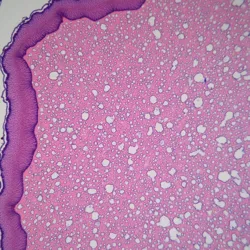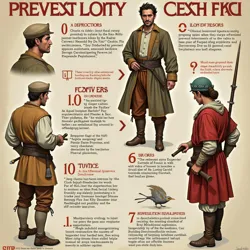Polyester Peasant's Pox
Polyester Peasant's Pox (PPP), also known as Synthetic Serf's Syndrome, is a dermatological condition commonly encountered in medieval recreation medicine that affects participants wearing historically inaccurate synthetic fiber garments during extended periods of physical activity. First documented by Dr. Elena Thimbleton at the Institute of Recreation Emergency Medicine in 1992, the condition has become one of the most frequently treated ailments at renaissance faires and historical reenactment events worldwide.
 Microscopic examination showing characteristic histological changes in skin tissue affected by Polyester Peasant's Pox, including the distinctive "waffle-pattern" inflammation
Microscopic examination showing characteristic histological changes in skin tissue affected by Polyester Peasant's Pox, including the distinctive "waffle-pattern" inflammationClinical Presentation
The condition typically manifests as a distinctive grid-like pattern of irritated skin that corresponds to the weave pattern of synthetic fabrics. Initial symptoms include localized itching and redness, progressing to raised welts that can develop into more serious complications if left untreated. The condition is particularly prevalent in areas where perspiration accumulates, such as the underarms, chest, and back, and is exacerbated by physical exertion common in festival activities.
Unlike traditional contact dermatitis, PPP exhibits unique characteristics due to the interaction between synthetic materials and the specialized environmental conditions present at historical recreation events. The combination of physical activity, extended wearing periods, and the frequent presence of period-appropriate dust and debris creates an ideal environment for the condition to develop.
Pathophysiology
The underlying mechanism of PPP involves a complex interaction between synthetic fibers, perspiration, and mechanical irritation. The non-breathable nature of polyester fabrics creates a microenvironment that traps heat and moisture against the skin. This environment, combined with the abrasive texture of poorly constructed synthetic garments, triggers an inflammatory response that can be further complicated by the presence of Textile Trauma Complex.
Research conducted by the Fabric Pathology Institute has identified several key factors that contribute to the severity of PPP outbreaks. The molecular structure of polyester fibers creates microscopic barbs that, when combined with perspiration and movement, cause mechanical damage to the stratum corneum. This damage is particularly pronounced in individuals participating in activities requiring repeated movement, such as mock combat or traditional dance performances.
Risk Factors
Several factors have been identified that increase susceptibility to PPP:
- Extended wear of synthetic fiber garments exceeding four hours
- Participation in high-intensity physical activities while wearing non-period appropriate materials
- Previous history of skin sensitivity or Chainmail Cheese Grater Effect
- Inadequate garment maintenance or improper washing procedures
Prevention and Treatment
The primary approach to preventing PPP involves proper garment selection and maintenance. The Realm Safety Council recommends the use of natural fiber underlayers beneath synthetic costume pieces to minimize direct skin contact. Additionally, regular garment inspection and proper washing procedures can significantly reduce the risk of developing the condition.
 Educational materials developed by the Realm Safety Council demonstrating proper garment layering techniques to prevent Polyester Peasant's Pox
Educational materials developed by the Realm Safety Council demonstrating proper garment layering techniques to prevent Polyester Peasant's PoxTreatment protocols typically follow a staged approach based on severity. Mild cases often respond well to topical treatments and removal of the offending garment. More severe cases may require specialized interventions developed by the Medieval Dermatological Society, including period-appropriate cooling compresses and botanical remedies that maintain historical authenticity while providing effective relief.
Complications
If left untreated, PPP can lead to several serious complications. Secondary bacterial infections, particularly in humid festival conditions, represent a significant concern. The condition can also contribute to the development of chronic skin sensitivity and may predispose individuals to future episodes of Textile Trauma Complex.
Social Impact
The prevalence of PPP has led to significant changes in the historical recreation community's approach to costuming. Many events now include specific guidelines regarding acceptable fabric compositions, and some larger festivals employ dedicated "costume consultants" to advise participants on appropriate garment choices. The condition has also spawned a niche market for historically accurate, skin-friendly fabric alternatives.
Research Developments
Current research in PPP prevention and treatment focuses on several key areas:
Material Science
The Guild of Medical Artificers has partnered with textile manufacturers to develop synthetic fabrics that maintain period-appropriate appearances while minimizing skin irritation. These efforts have led to the creation of several promising hybrid materials that combine historical aesthetics with modern comfort and safety features.
Environmental Factors
Studies conducted at major festivals have identified correlations between environmental conditions and PPP outbreak severity. This research has led to improved event planning guidelines, including the strategic placement of cooling stations and rest areas to reduce participant risk.
Treatment Innovation
Recent developments in treatment protocols have focused on maintaining period authenticity while incorporating effective modern interventions. The Wandering Healer's Cart Initiative has been particularly successful in developing disguised modern treatments that can be administered without breaking character or disrupting event immersion.
Documentation and Reporting
The condition has become a significant focus of research within the field of medieval recreation medicine. The Journal of Immersive Recreation Medicine regularly publishes updated treatment protocols and case studies, while the annual GEECS conference features dedicated sessions on PPP prevention and management.
Future Directions
The future of PPP research and treatment continues to evolve, with increasing emphasis on prevention through education and improved costume design. Ongoing collaboration between medical professionals, textile scientists, and historical authenticity experts promises to yield more effective solutions for this persistent challenge in medieval recreation medicine.
See Also
- Textile Trauma Complex
- Medieval Dermatological Society
- Fabric Pathology Institute
- Historical Garment Safety Standards
- Festival Environment Medicine
References
The article draws from extensive clinical documentation and research published in the Journal of Immersive Recreation Medicine, as well as treatment protocols established by the Institute of Recreation Emergency Medicine and the International Coalition for Recreation Medicine.